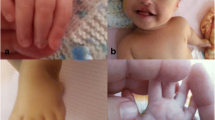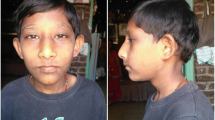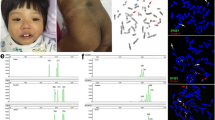Summary
A psychomotor-retarded infant with minor dysmorphic signs and a karyotype 46.XY,r(21)mat in lymphocytes is reported. The mother is phenotypically normal but shows the same unstable r(21). This is another case demonstrating that a chromosomal aberration does not necessarily lead to infertility by meiotic failure. Nevertheless, segregation of ring chromosomes is problematic for two reasons: mitotic problems of the ring structure itself and synaptic difficulties during the pachytene stage.
Similar content being viewed by others
References
Aronson DC, Jansweijer MC, Hoovers JM, Barth PG (1987) A male infant with holoprosencephaly, associated with ring chromosome 21. Clin Genet 31:48–52
Back E, Voiculescu I, Brünger M, Wolff G (1989) Familial ring (20) chromosomal mosaicism. Hum Genet 83:148–154
Burden M, Lupascu E, Margineanu L (1973) A familial case of 17 R ring-shaped chromosome of group E with transmission from father to son. Rev Med Chir Soc Med Nat Iasi 77:353–357
Crusi A, Engel E (1986) Diagnostic prenatal de trois cas de chromosome G en anneau: un 21 et deux 22, dont un de novo. Ann Génét (Paris) 29:253–260
Dallapiccola B, De Filippis V, Notarangelo A, Perla G, Zelante L (1986) Ring chromosome 21 in healthy persons: different consequences in females and in males. Hum Genet 73:218–220
Hertz JM (1987) Familial transmission of a ring chromosome 21. Clin Genet 32:35–39
Hoo JJ, Obermann U, Cramer H (1974) The behavior of ring chromosome 13. Hum Genet 24:161–171
Kosztolányi G (1987) Does “ring syndrome” exist? An analysis of 207 case reports on patients with a ring autosome. Hum Genet 75:174–179
McIlree ME, Tulloch WS, Newsam JE (1966) Studies on human meiotic chromosomes from testicular tissue. Lancet I:679–682
Miller K, Reimer A, Schulze B (1987) Tandem duplication chromosome 21 in the offspring of a ring chromosome 21 carrier. Ann Génét (Paris) 30:180–182
Palmer CG, Hodes ME, Reed T, Kojetin J (1977) Four new cases of ring 21 and 22 including familial transmission of ring 21. J Med Genet 14:54–60
Schinzel A (1984) Catalogue of unbalanced chromosome aberrations in man. de Gruyter. Berlin New York
Schmid W, Tenconi R, Baccichetti C, Caufin D, Schinzel A (1983) Ring chromosome 21 in phenotypically apparently normal persons: report of two families from Switzerland and Italy. Am J ed Genet 16:323–329
Stetten G, Sroka B, Corson VL, Boehm CD (1984) Prenatal detection of an unstable ring 21 chromosome. Hum Genet 68:310–313
Stoll C, Roth MP (1983) Segregation of a 22 ring chromosome in three generations. Hum Genet 63:294–296
Author information
Authors and Affiliations
Rights and permissions
About this article
Cite this article
Kennerknecht, I., Barbi, G. & Vogel, W. Maternal transmission of ring chromosome 21. Hum Genet 86, 99–101 (1990). https://doi.org/10.1007/BF00205185
Received:
Revised:
Issue Date:
DOI: https://doi.org/10.1007/BF00205185




